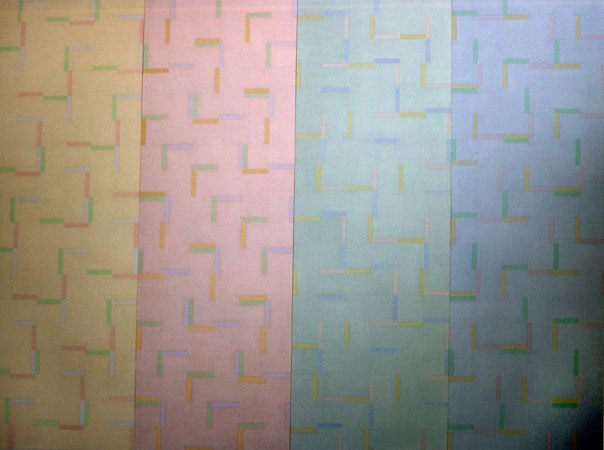

Paintings
I continued to paint grids throughout my undergraduate course, though I refined the techniques and ended up putting washes of acrylic on canvas that had barely been sized. I worried about the way the coloured areas met up at the edges of the rectangles. It’s difficult to do with stains, which tend to spread.

4piece
I spent a lot of time trying out different ways of organising a surface as a grid. I was determined to understand what was going on when one area met up with another, and how the attributes of one area distinguished it from its neighbour. In the process of trying to work this out, I produced a collection of paintings.
But despite the effort, I ended up back where I started. I was collecting things again, trying to pin it all down like the insects in my boxes and make it all into an orderly pattern. There was satisfaction in this, but in retrospect it was a rather closed world.
I spent another year after leaving St Martins, working in a cold studio in Brixton, painting tight gouache grids on paper.
Then I got bored with it and started experimenting in all sorts of different directions. It was exciting, and also disorientating.…
I hung on to the staining idea, and you can see that I'm still dealing with marks on a surface activating a sensation of a space behind that surface. I was using bright colours again. The change was refreshing.
By the time I started my postgraduate course at the Slade school in London, I was pretty much all over the place again. They had taken me on when I was painting beautiful tight systems pieces and now I was painting anything, anyhow. Even rabbits.
By the second year there I desperately needed some order. I looked, as artists often do, when they feel lost, to figuration... I started painting traditional subjects, particularly still life. I felt I needed some of that traditional painting technique that I had never learnt at school.
Also while at the Slade, there was a series of lectures by the professor there, an extraordinary art historian and artist called Lawrence Gowing. This was the first time I was really initiated into the history of art, especially the Renaissance. I was bowled over by coming into contact with paintings like this one, a Giotto.
In April 1982, into my last few months at the Slade, I went to Venice with two artist friends. There, I had the experience of seeing painting in the architectural and cultural environment for which it was made. Venice got under my skin, but lay there dormant for a little while longer. This is a Titian. It's Bacchus and Ariadne, done when Titian was a young man, and typically of that time, using brilliant colours and clear forms.
This is another Titian... this time done as an old man (and he lived a long life).
It’s the story of the Death of Actaeon. Look at the incredible moodiness that this painting has compared to that last one, and how the forms start to merge together - the brushwork much more loose and expressive.
Here's another moody Titian, Nymph and Shepherd, full of sexual tension and suggestion.
Next chapter: Dynamic spaces